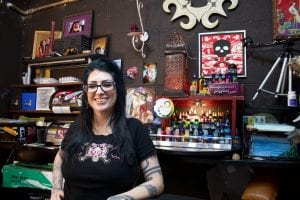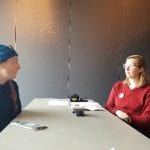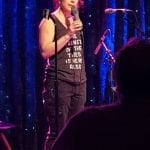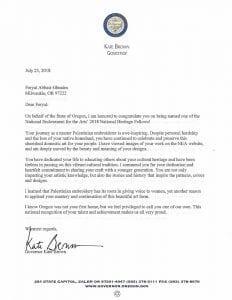Alina Mansfield
In the Winter and Spring of 2018, I attended many of Lane County’s regional cultural events, festivals, and fairs to scout out tradition keepers for the Willamette Valley Folklife Survey.
The Willamette Valley is homeland to the Kalapuya Tribes, with the Molalla calling the foothills of the Cascades home. More recently, a significant Scandinavian population settled Junction City, where the annual Scandinavian Festival attracts attendees from far and wide to try a taste of Danish aebelskiver (apple pastry), participate in Swedish folk dancing, or watch a Norwegian artist demonstrate Hardanger embroidery (usually white on white embroidery with cutwork to create a lacy effect). Eugene’s Sons of Norway Sonja Lodge (Lane County) participate in the festival, and I had the pleasure of getting to know many of their members at their annual Lutefisk dinner in January. Before the dinner, I watched lodge members peel potatoes for the lefse (potato flatbread) and bake traditional Norwegian desserts and cookies. And I got to have my first taste ever of lutefisk (cod preserved in lye, rinsed and boiled, then served hot with butter). As someone of Norwegian descent myself, this notorious cultural delicacy was on my bucket list, and I was not disappointed. Lodge members did assure me, however, that their lutefisk used to be much stronger!
I also attended a lodge-sponsored Norwegian Sweater Night for which members donned their Norwegian-style knitted sweaters and shared stories about the talented needlewomen who made them. I discovered that Norwegian knitters make their purl stitches without moving the yarn to the front of the needle. There was a palpable celebration of their heritage in such stories, and a sense of humor and pride in the discussion that detailed how this unique style differs from standard knitting.
- Sons of Norway cookie baking
- Lutefisk dinner
- Norwegian sweater group photo
Through these activities, I was able to meet and interview some very special traditional artists, including PattiJo Meshnick, a Norwegian Rosemåler. Rosemåling is a traditional Norwegian decorative art that involves painting objects with stylized flower motifs. With a focus on symmetry, brightness, and depth of color, Meshnik decorates pots, clocks, hangers, cards, and more. Meshnik’s eye for design is key for her rosemåling; she uses a combination of traditional design elements, techniques and materials to achieve the right effect. She always starts with a root at the center; loading brushes with various thicknesses, she paints S strokes and C strokes, adding color, shading, and then fine lines for depth. According to Meshnik, regional styles developed as a result of the distance between the deep Norwegian valleys; traveling artists would stay with a family all winter, cheering up their houses and soot-covered furniture with brightly colored designs. Like others who learned the techniques of rosemåling from master artists, Meshnik also continues to study with master teachers to learn various regional styles. She notes that traditional rosemåling became an endangered art form in Norway; teaching is essential for its survival. “Folk art is a hard thing to keep alive in modern days; you need to find someone who wants to teach, and someone who wants to learn.”
 In February, I celebrated the Asian Lunar New Year of the Dog in Eugene at the “Bark to the New Year” festival. There I met Kathy Hoy, a traditional Chinese ink brush painter. Before moving to Eugene to attend college, Kathy learned to paint by apprenticing with Huang Jun Pin, a famous traditional Chinese brush painter in Taipei, Taiwan. She creates traditional Chinese ink wash and watercolor on rice paper. Many of her paintings have traditional symbols of nature such as water, fish, birds, and mountain landscapes as well as Chinese characters.
In February, I celebrated the Asian Lunar New Year of the Dog in Eugene at the “Bark to the New Year” festival. There I met Kathy Hoy, a traditional Chinese ink brush painter. Before moving to Eugene to attend college, Kathy learned to paint by apprenticing with Huang Jun Pin, a famous traditional Chinese brush painter in Taipei, Taiwan. She creates traditional Chinese ink wash and watercolor on rice paper. Many of her paintings have traditional symbols of nature such as water, fish, birds, and mountain landscapes as well as Chinese characters.
In April, I headed out to Vida, Oregon, for the McKenzie Drift Boat Festival, where I met river guides and a conch mushroom artist, learned about wooden drift boats, and watched fly fishers demonstrate how to make fly ties. Along the way, I marveled at the chainsaw art along the McKenzie Highway, which celebrates these roadside sculptures each year in July at the McKenzie River Chainsaw & Arts Festival in Blue River.
- Draft Boat Festival
- Fly Tie
- Chainsaw Art
Lane County also hosted the Evergreen Tattoo Invitational in March, which prompted me to speak with local tattoo artist, Suzen Tattoozen, co-owner of Whiteaker Tattoo Collective in Eugene’s Whiteaker neighborhood. She is known for her unique custom designs, and ornate, embellished, illustrative watercolor styles. Tattoozen has high standards and is very passionate about representing the industry with the highest of integrity. She says no to tattoos she believes will not be good art, and she asks a lot of questions before agreeing to do a tattoo. But she also believes in never judging a client’s ideas. She thinks of tattoos and body art as the “freedom of owning yourself.” She is slow to start when she begins her work because she wants to get to know her client’s skin. Tattoozen also runs Transformation Ink, a tattoo-based charity; she believes that tattoos are empowering and transformative and that receiving a good tattoo is treating one’s self to self-care and self-love.
Tattoos, rosemåling, and fly fishing may seem very different from each other, but these culture keepers all share a love for detail in artistry, symmetry, design; an attention to story and heritage; and a commitment to passing on their skills and knowledge to others. Folk and traditional artists like these continue to enrich Lane County’s diverse cultural and regional heritage.























